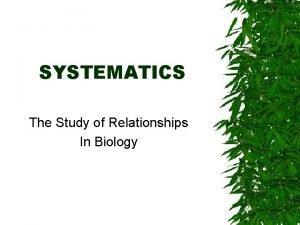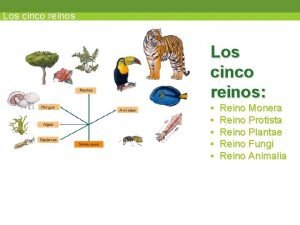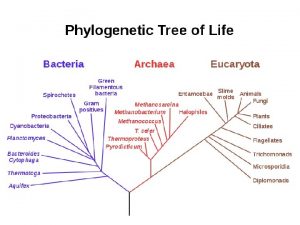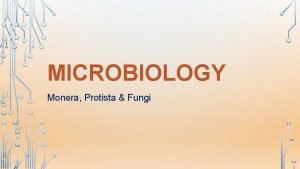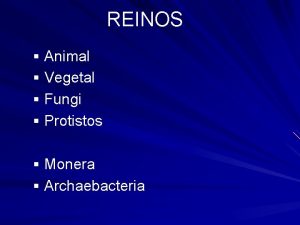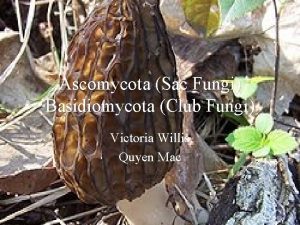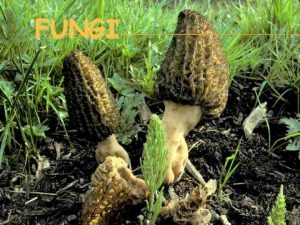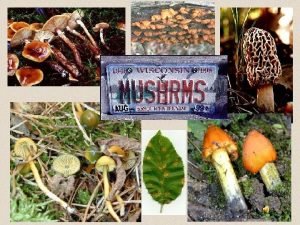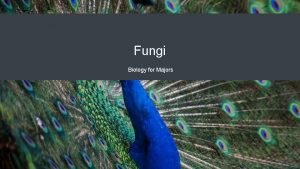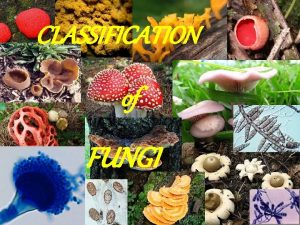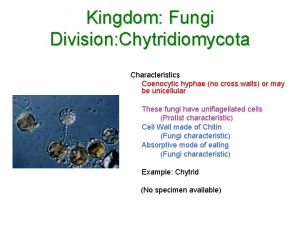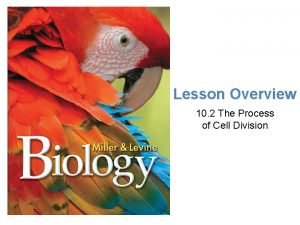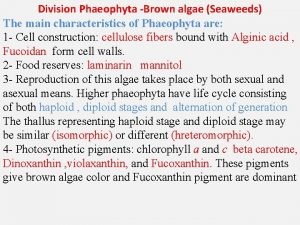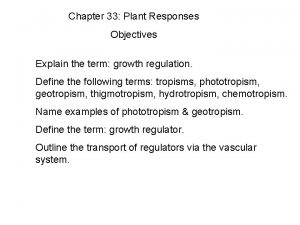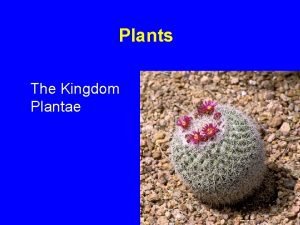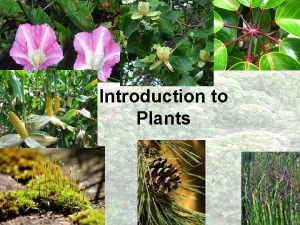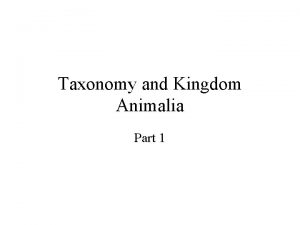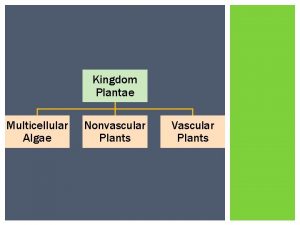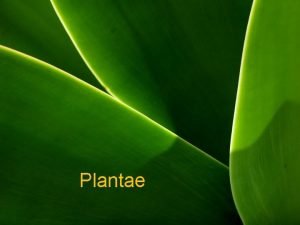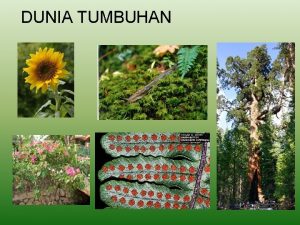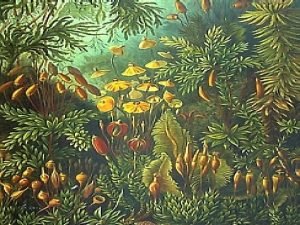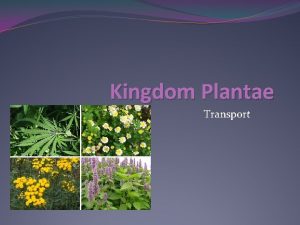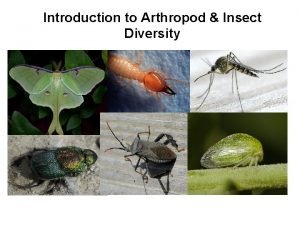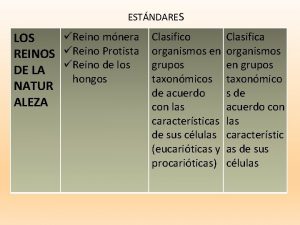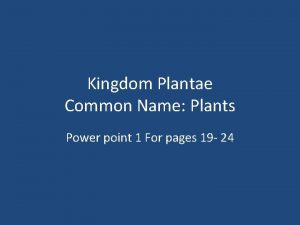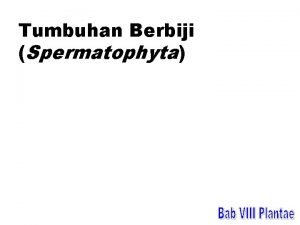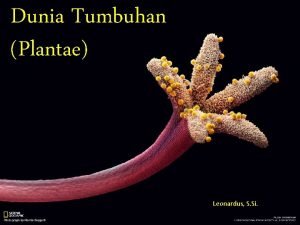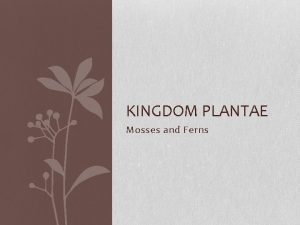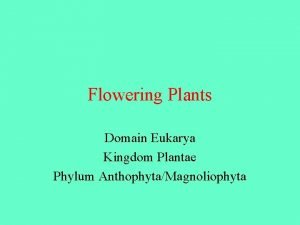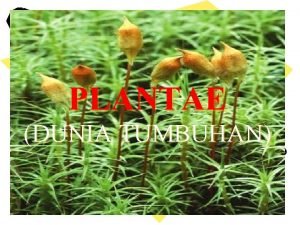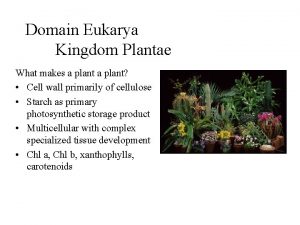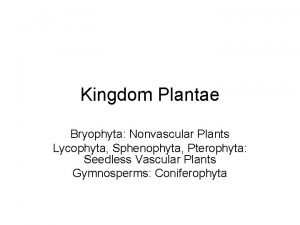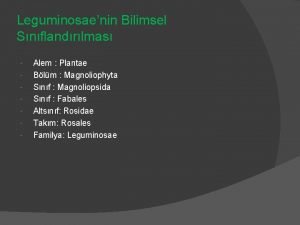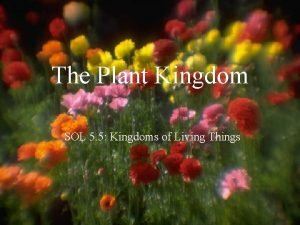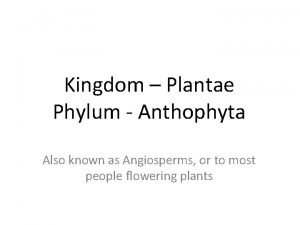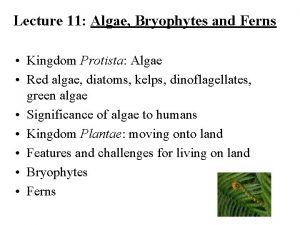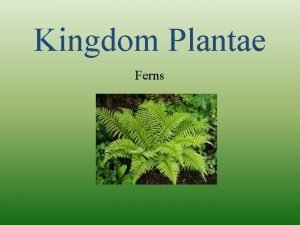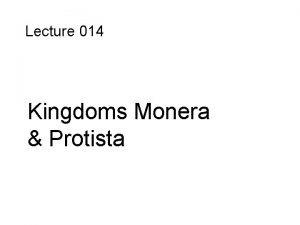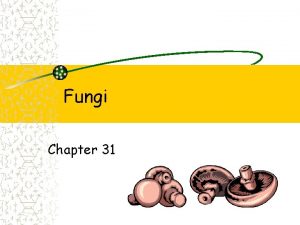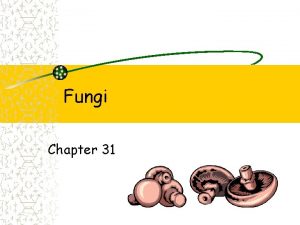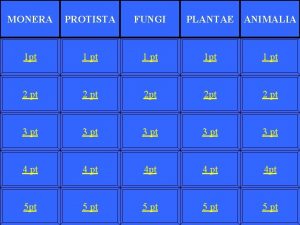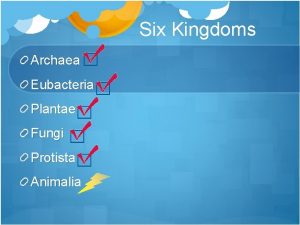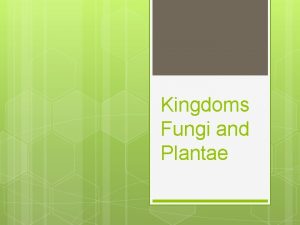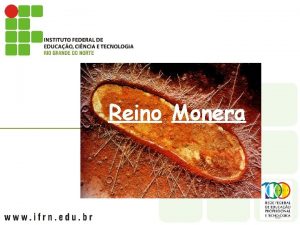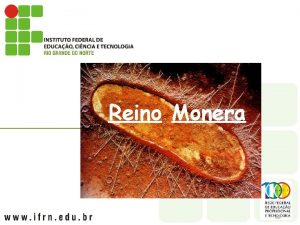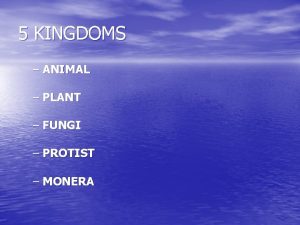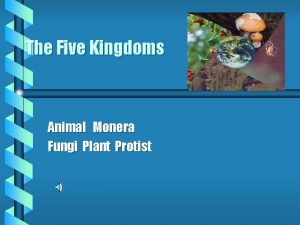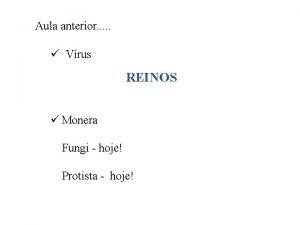Division of Plant Kingdoms Monera Protista Fungi Plantae











































































- Slides: 75

Division of Plant Kingdoms Monera, Protista, Fungi, Plantae, Anamilia * Divisions (phyta) of Plant • Bacteriophyta • Cyanophyta • Phycophyta • Mycophyta • Bryophyta • Pteridophyta • Spermatophyta Subdivision: Gymnospermae Subdivision: Angiospermae Class: Monocotyledones Class: Dicotyledones Subclass: Apetale Dialypetalae Sympetalae

Division: Spermatophyta (Seed-bearing) Subdivision: Gymnospermae Subdivision: Angiospermae Class: Monocotyledones Class: Dicotyledones Subclass: Apetale Dialypetalae Sympetalae

• • Division: Spermatophyta are the conifers (gymnosperms)(have strobili as reproduvtive organ) and flowering plants (have flowers as reproduvtive organ). Plants with true roots, stem and leaves Reproduction is by seeds, sometimes supplemented by vegetative propagation have well-developed vascular bundles

Subdivision: Gymnospermae (Cone-bearing) Evergreen shrubs or trees Resin ducts are found in most of the species Strobili unisexual or bisexual, ovules and resulting seeds not enclosed in carpels Vascular bundles collateral and arranged in cylindrical about a pith (the xylem region conatins tracheids but no tracheae) Phloem have only sieve-tube members but no companion cells Monoecious or dioecious They have no perianth Pollens have wings, and pollination is by wind (Anemophily) Seeds are polycotyledones Leaves are scale or needle like

Subdivision: Gymnospermae (Conifer) 1 -Class: Cycadinae Order: Cycadales Fam: Cycadaceae Genus: Cycas Species: Cycas revoluta Use: as food It has starch at cortex and pith of stem.



Male cone Female cone

Zamia female cone

2 -Class: Ginkgoiae Order: Ginkgoales Fam: Ginkgoaceae Genus: Ginkgo Species: Ginkgo biloba

Fam: Ginkgoaceae These are large trees, with simple leaves, recognized by their leaves with dichotomic venation, today their remains only one relict species, Ginkgo biloba. dioecious plants; the male and female strobili, on separate trees, are borne on short stalks. seed outer portion becomes soft and fleshy like a fruit, it has a disagreeable odor, and for this reason staminate trees are sometimes prefered to pistillate for ornamental planting. Seeds contains neurotoxins.

Use: Medicinal Ginkgo Folium Flavoniod (ginkgo flavonoids, ginkgolid, bilobalid) Because of expansionary effect on blood vessels, it has used in disease seen in advanced ages, the forgetfulness of dementia with memory loss, hearing tinnitus and vertigo






3 -Classis: *Coniferae

3 -Classis: *Coniferae 1 -No female strobili, not forming cones, red, fleshy drupe fruit aril around seed. . . Taxaceae 1 - Have female strobili, fruit is not drupe 2 -Leaves oppositte or vertisillate, scaly. . . . Cupressaceae 2 -Leaves alternate, scaly or needle like (acicular) 3 - Leaves are needle like. . . . . Pinaceae 3 -Leaves are scaly 4 -1 ovule in carpels of female strobili. . . . . Araucariaceae 4 - More than 2 ovule in carpels of female strobili. . . . . Taxodiaceae

3 -Classis: *Coniferae Order 1: Taxales Fam: Taxaceae Genus: Taxus Species: Taxus baccata T. brevifolia

Fam: Taxaceae Resin bearing, evergreen, dioecious, leaves are alternate, linear 1 -3 cm, acute, similar Abies leaf; but have no 2 wax line parallel to midrib at ventral surface of lamina. not forming cones. red, fleshy aril around seed Poisoning from taxanes, the taxines and taxol, both of which are nitrogenous ester alkaloids Generally contains toxic leves in all parts of the plants (except the fleshy aril around seed)

Use: Medicinal Taxol, found at the bark of this species in structure of diterpene, has antitumoral activity

Taxus - yew

Order 2: Pinales i) Fam: Araucariaceae Genus: Araucaria Species: Araucaria araucana A. excelsa Genus: Agathis

Use: Medicinal It has abuntant resin in stem and this resin is used in the preparation of pharmaceutical plaster

Araucaria - Norfolk Island Pine

Agathis

ii) Fam: Pinaceae Genus: Pinus Species: P. pinea P. halapensis P. brutia P. silvestris P. nigra

Fam: Pinaceae A very important family of cone-bearing plants, mostly evergreen trees, woody, All parts of the tree contain intercellular resin duct. linear, alternate leaves, or have scales. In the pines the leaf base are enclosed in sheaths— 1, 2, 3, 4 or 5 leaves depending on species, growing from each sheath. In the other genera the leaves are single. male and female strobili borne on the same tree, seeds bears a broad wing Use as lumber

Use: Medicinal Oleoresin obtained from wounding of stem of P. brutia As a result of distillation with water vapour from oleoresin, volatile oil is obtained called Terebinthina Oleum. The residue is also drug, Colophonium Terebinthina Oleum, used in the production of creams, applied externally for rheumatism, relieve pain. Analgesics in veterinary medicine, has antiseptic effect in respiratory and urinary tract diseases Colophonium used in in the preparation of pharmaceutical plaster From wood of branches and trunk of P. brutia and P. nigra with dry distillation tar is obtained called Pini Pix. Used in respiratory and urinary tract diseases in pharmaceuticals and in particular used in the skin






Pinus - pine

Pinus - pine


Genus: Abies Species: A. cilicica A. alba A. balsamea A. bornmülleriana A. nordmanniana

From wounding of the stem of A. balsamea, Balsamum Canadense, a oleoresin is obtained. It is used to prepare permanent preparat (slide) for microscope investigations

Abies - fir





Abies - fir

Cins: Picea Species: P. orientalis P. pungens P. excelsa Use as lumber

Picea - spruce

Genus: Cedrus Species: C. libani C. brevifolia (Cyprus species) Genus: Larix decidua From the C. libani, Cedri Folia, it contains volatile oil that is used in perfumery industry Medicinal use From branches and trunk of C. libani tar is obtained called Cedri Oleum, it is a folk medicine, used in respiratory and urinary tract diseases in pharmaceuticals and in particular used in the skin diseasaes of animals





Larix - larch

iii) Fam: Taxodiaceae Genus: Sequoia Species: S. sempervirens Genus: Sequiadendron Species: S. giganteum (redwood)

Sequoiadendron - the giant sequoia

iv) Fam: Cupressaceae Genus: Juniperus Species: Juniperus oxycedrus J. communis J. drupacea (Arceuthos drupacea) J. sabina J. phoenicea J. virginiana

With dry distillation from branches of J. oxycedrus tar is obtained called Juniperi Pix. Strong antiseptic from the outside skin diseases, found in soap, creams for scabies, eczema, ringworm, is used in the treatment of oily hair. As a result of distillation with water vapour from wood of J. viriginiana Cedri Oleum is obtained used as microscopic immersion. From the J. communis, Juniperi Fructus used as tonic, and used for hypertension

Juniperus juniper or cedar


Genus: Cupressus Species: Cupressus sempervirens Immature cones are rich in tannin. Formerly used as astringent (tissue and vessels constrict drug), now and in the disorder of vein circulation, especially in medicins of hemaroid and heir, acvtivity is due to falavonoids. Essential oils obtained from the young branches of C. sempervirens, Cupressi Oleum, is effective as antiseptic and antispazmodic and is sprayed to the room and on the clothes of croupy patients

Genus: Thuja occidentalis Young branch tips of this species, Thujae Summitates is used as astringent, diuretic and emenagog but at the same time it can be toxic.



4 -Class: Gnetinae Order: Gentales Fam: Ephedraceae Genus: Ephedra Species: E. campylopoda E. major The aerial parts of this genus, Ephedrae Herba, stimulants of pulmonary and contractionary of veins, effects of drug is from its alkaloids especially, ephedrin.



male

Female

Fam: Welwitschiaceae


Male pollen cones

Welwitschia microsporangiate cones

Female plant

Welwitschia cones with seeds
 Monera protista fungi plantae animalia
Monera protista fungi plantae animalia Types of eubacteria
Types of eubacteria Monera, protista, fungi, plantae animalia
Monera, protista, fungi, plantae animalia Briofita
Briofita Reino fungi y protista
Reino fungi y protista Protista
Protista Plantae is prokaryotic or eukaryotic
Plantae is prokaryotic or eukaryotic The three domains are _____.
The three domains are _____. Why is protista the junk drawer of kingdoms
Why is protista the junk drawer of kingdoms Fungi obtain energy
Fungi obtain energy Reino monera y protista
Reino monera y protista Domain of kingdom protista
Domain of kingdom protista Kingdom fungi and kingdom plantae similarities
Kingdom fungi and kingdom plantae similarities Plantae kingdom drawing
Plantae kingdom drawing Reino fungi y protista
Reino fungi y protista Plant - multicellular eukaryote of the kingdom plantae
Plant - multicellular eukaryote of the kingdom plantae Sac fungi kingdom
Sac fungi kingdom Club fungi are morels truffles bracket fungi yeast
Club fungi are morels truffles bracket fungi yeast Deuteromycota
Deuteromycota Zygomycota
Zygomycota Ainsworth classification of fungi slideshare
Ainsworth classification of fungi slideshare What structure
What structure Sythetic division
Sythetic division 369 times 2
369 times 2 Long division rational functions
Long division rational functions Long division how to
Long division how to What happens in cytokinesis
What happens in cytokinesis Characteristics of brown algae
Characteristics of brown algae Division plant
Division plant Tronsmo plant pathology and plant diseases download
Tronsmo plant pathology and plant diseases download Define plant breeding
Define plant breeding Tronsmo plant pathology and plant diseases download
Tronsmo plant pathology and plant diseases download Taichum
Taichum Tronsmo plant pathology and plant diseases download
Tronsmo plant pathology and plant diseases download Plant introduction in plant breeding
Plant introduction in plant breeding Kingdom plantae
Kingdom plantae Cladogram of kingdoms
Cladogram of kingdoms Plantae common characteristics
Plantae common characteristics Lycodiophyta
Lycodiophyta Nematocysts
Nematocysts Phaeophyta structure
Phaeophyta structure Phylogenetic tree of 6 kingdoms
Phylogenetic tree of 6 kingdoms Peta konsep tumbuhan berbiji
Peta konsep tumbuhan berbiji Tubuh lumut yang berbentuk lembaran disebut
Tubuh lumut yang berbentuk lembaran disebut Sphagnum moss
Sphagnum moss Dunia plantae
Dunia plantae Karioteka
Karioteka How do plantae get nutrients
How do plantae get nutrients Reino plantae
Reino plantae Kingdom plantae chart
Kingdom plantae chart Archaebacteria characteristics
Archaebacteria characteristics Reino de ü
Reino de ü Autotrofe
Autotrofe Pohlia nutans
Pohlia nutans Brifita
Brifita Introduction of kingdom plantae
Introduction of kingdom plantae Strobilus jantan melinjo
Strobilus jantan melinjo Plantae is unicellular or multicellular
Plantae is unicellular or multicellular Subkingdom of kingdom plantae
Subkingdom of kingdom plantae Lumut daun
Lumut daun Plantae kingdom
Plantae kingdom Lycopodinae
Lycopodinae Flowering plants phylum
Flowering plants phylum Habitat del reino plantae
Habitat del reino plantae Daur hidup tanaman paku
Daur hidup tanaman paku Archegonia domain
Archegonia domain Lycophyta gametophyte
Lycophyta gametophyte Plantae alemi
Plantae alemi Structure of kingdom plantae
Structure of kingdom plantae Phylum anthophyta examples
Phylum anthophyta examples Kingdom plantae
Kingdom plantae Animalia plantae
Animalia plantae Character of plants
Character of plants Funcion de los protozoarios
Funcion de los protozoarios Ferns
Ferns Cavidad celómica
Cavidad celómica
